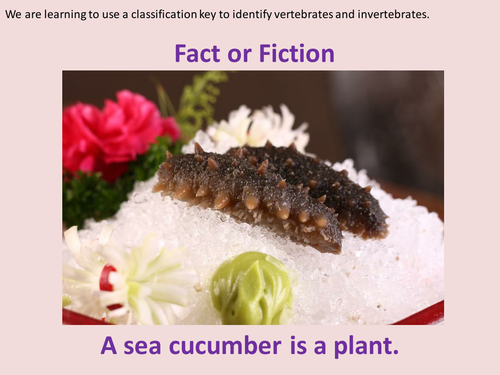






Lesson PowerPoint, planning and activities for identifying vertebrates and invertebrates and introducing children to scientific classification keys.
The third in a series of lessons to develop children's knowledge about 'Living Things and Their Habitats,' for the 2014 primary curriculum. Links to coverage of the curriculum are explicit in the planning.
We are learning to use a classification key to identify vertebrates and invertebrates.
An interesting 'fact or fiction' starter to intrigue children and develop their scientific discussions..
Recaps, revisits and builds on prior learning on living things and how they are grouped.
Introduces children to a scientific classification key at a basic lesson. Initially through a verbal, fun, whole class exercise and moving into written scientific keys to identify vertebrates and invertebrates.
Develop's children's scientific knowledge about vertebrates and invertebrates.
Lots of 'mastery' thinking required through the questions posed, for deepening and mastering learning.
Choice of 3 differentiated follow up activities (all of which are provided as well as being explained on the PowerPoint).
Plenary requires mastery level thinking and leads into next lesson by encouraging children to consider other ways in which animals could be grouped.
All images have been taken from: http://search.creativecommons.org/ where no attribution is required.
The third in a series of lessons to develop children's knowledge about 'Living Things and Their Habitats,' for the 2014 primary curriculum. Links to coverage of the curriculum are explicit in the planning.
We are learning to use a classification key to identify vertebrates and invertebrates.
An interesting 'fact or fiction' starter to intrigue children and develop their scientific discussions..
Recaps, revisits and builds on prior learning on living things and how they are grouped.
Introduces children to a scientific classification key at a basic lesson. Initially through a verbal, fun, whole class exercise and moving into written scientific keys to identify vertebrates and invertebrates.
Develop's children's scientific knowledge about vertebrates and invertebrates.
Lots of 'mastery' thinking required through the questions posed, for deepening and mastering learning.
Choice of 3 differentiated follow up activities (all of which are provided as well as being explained on the PowerPoint).
Plenary requires mastery level thinking and leads into next lesson by encouraging children to consider other ways in which animals could be grouped.
All images have been taken from: http://search.creativecommons.org/ where no attribution is required.
Something went wrong, please try again later.
This resource hasn't been reviewed yet
To ensure quality for our reviews, only customers who have purchased this resource can review it
Report this resourceto let us know if it violates our terms and conditions.
Our customer service team will review your report and will be in touch.
£2.35
